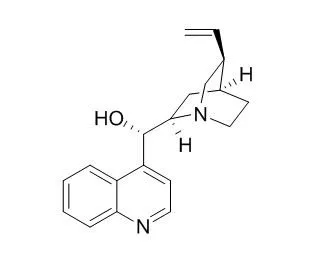| Cell Research: |
| Environ Toxicol. 2011 Aug;26(4):424-31. | | Hydrocinchonine, cinchonine, and quinidine potentiate paclitaxel-induced cytotoxicity and apoptosis via multidrug resistance reversal in MES-SA/DX5 uterine sarcoma cells.[Pubmed: 20196146] | Multidrug resistance (MDR) is one of important issues to cause the chemotherapy failure against cancers including gynecological malignancies. Despite some MDR reversal evidences of natural compounds including quinidine and Cinchonine, there are no reports on MDR reversal activity of hydroCinchonine with its analogues quinidine and Cinchonine especially in uterine sarcoma cells.
METHODS AND RESULTS:
Thus, in the current study, we comparatively investigated the potent efficacy of hydroCinchonine and its analogues quinidine and Cinchonine as MDR-reversal agents for combined therapy with antitumor agent paclitaxel (TAX). HydroCinchonine, Cinchonine, and quinidine significantly increased the cytotoxicity of TAX in P-glycoprotein (gp)-positive MES-SA/DX5, but not in the P-gp-negative MES-SA cells at nontoxic concentrations by 3-(4,5-dimethylthiazol-2-yl)-2,5--diphenyltetrazolium bromide (MTT) assay. Rhodamine assay also revealed that hydroCinchonine, Cinchonine, and quinidine effectively enhanced the accumulation of a P-gp substrate, rhodamine in TAX-treated MES-SA/DX5 cells compared with TAX-treated control. In addition, hydroCinchonine, Cinchonine, and quinidine effectively cleaved poly (ADP-ribose) polymerase (PARP), activated caspase-3, and downregulated P-gp expression as well as increased sub-G1 apoptotic portion in TAX-treated MES-SA/DX5 cells.
CONCLUSIONS:
Taken together, hydroCinchonine exerted MDR reversal activity and synergistic apoptotic effect with TAX in MES-SA/DX5 cells almost comparable with quinidine and Cinchonine as a potent MDR-reversal and combined therapy agent with TAX. |
|






 Cell. 2018 Jan 11;172(1-2):249-261.e12. doi: 10.1016/j.cell.2017.12.019.IF=36.216(2019)
Cell. 2018 Jan 11;172(1-2):249-261.e12. doi: 10.1016/j.cell.2017.12.019.IF=36.216(2019) Cell Metab. 2020 Mar 3;31(3):534-548.e5. doi: 10.1016/j.cmet.2020.01.002.IF=22.415(2019)
Cell Metab. 2020 Mar 3;31(3):534-548.e5. doi: 10.1016/j.cmet.2020.01.002.IF=22.415(2019) Mol Cell. 2017 Nov 16;68(4):673-685.e6. doi: 10.1016/j.molcel.2017.10.022.IF=14.548(2019)
Mol Cell. 2017 Nov 16;68(4):673-685.e6. doi: 10.1016/j.molcel.2017.10.022.IF=14.548(2019)